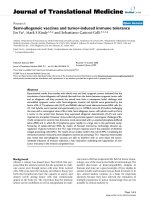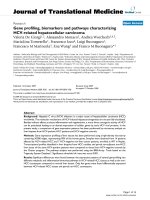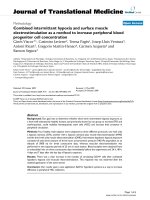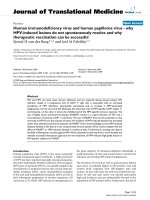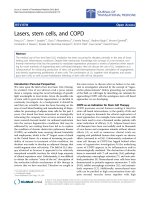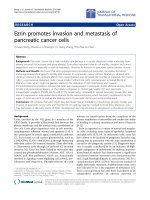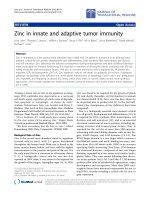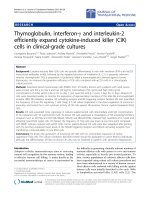báo cáo hóa học:" En bloc excision and autogenous fibular reconstruction for aggressive giant cell tumor of distal radius: a report of 12 cases and review of literature" doc
Bạn đang xem bản rút gọn của tài liệu. Xem và tải ngay bản đầy đủ của tài liệu tại đây (497.19 KB, 9 trang )
RESEARCH ARTICLE Open Access
En bloc excision and autogenous fibular
reconstruction for aggressive giant cell tumor
of distal radius: a report of 12 cases and review
of literature
Raghav Saini
1
, Kamal Bali
1*
, Vikas Bachhal
1
, Aditya K Mootha
1
, Mandeep S Dhillon
1
, Shivinder S Gill
1,2
Abstract
Introduction: Giant cell tumor (GCT) of distal radius follows a comparatively aggressive behaviour. Wide excision is
the management of choice, but this creates a defect at the distal end of radius. The preffered modalities for
reconstruction of such a defect include vascularized/non-vascularized bone graft, osteoarticular allografts and
custom-made prosthesis. We here present our experience with wide resection and non-vascularised autogenous
fibula grafting for GCT of distal radius.
Materials and methods: Twelve patients with a mean age of 34.7 years (21-43 years) with Campanacci Grade II/III
GCT of distal radius were managed with wide excision of tumor and reconstruction with ipsilateral nonvascularised
fibula, fixed with small fragment plate to the remnant of the radius. Primary autogenous iliac crest grafting was
done at the fibuloradial junction in all the patients.
Results: Mean follow up period was 5.8 years (8.2-3.7 years). Average time for union at fibuloradial junction was
33 weeks (14-69 weeks). Mean grip strength of involved side was 71% (42-86%). The average range of movements
were 52° forearm supination, 37° forearm pronation, 42° of wrist palmerflexion and 31° of wrist dorsiflexion with
combined movements of 162°. Overall revised musculoskeletal tumor society (MSTS) score averaged 91.38%
(76.67-93.33%) with five excellent, four good and three satisfac tory results. There were no cases with graft related
complications or deep infections, 3 cases with wrist subluxation, 2 cases with non union (which subsequently
united with bone grafting) and 1 case of tumor recurrence.
Conclusion: Although complication rate is high, autogenous non-vascularised fibular autograft reconstruction of
distal radius can be considered as a reasonable option after en bloc excision of Grade II/III GCT.
Introduction
Giant cell tumor is a benign aggressive bone tumor of
obscure origin presenting in 3
rd
and 4
th
decade of life,
and carries a definite female preponderance [1]. After
distal femur and proximal tibia, distal radius happens to
be the most common site of occurrence for GCT [1,2].
This site has a further distinction of having more
aggressive behaviour of GCT with higher chances of
recurrences and malignant transformation [3,4].
Treatment options for GCT at this site include curettage
with bone gr afting or cementing, en blo c excision and
reconstruction with non vascular or vascular fibular
autograft, osteoar ticular allograft, ulnar translocation, or
endoprosthesis [5-14]. Although amputation would
seem likely to be curative, it is seldom warranted in a
tumor that rarely metastasizes.
TherecurrencerateforprimarytreatmentofGCTis
relatively higher for curettage or extended curettage as
compared to en bloc excision, making latter a more sui-
table and reliable option in cases showing aggressive
lesions which so often is the case in distal radius
[2,3,8,15,16]. Although providing the best chance of
* Correspondence:
1
Deptt of Orthopaedics, Postgraduate Institute of Medical Education and
Research (PGIMER), Chandigarh, India
Full list of author information is available at the end of the article
Saini et al. Journal of Orthopaedic Surgery and Research 2011, 6:14
/>© 2011 Saini et al; licensee BioMed Central Ltd. This is an Open Access article distributed under the terms of the Creative Comm ons
Attribution License ( which pe rmits unrestricted use, distribution, and reproduction in
any medium, provided the original work is properly cited.
cure from GCT, en bloc excision of distal radius pre-
sents c omplex reconstructive problems [16-21]. Recon-
struction of wrist after en bloc excision of distal radius
is a challenging task. Most patients are young a ctive
adults demanding cosmetically acceptable and function-
ally adequate wrist. We have routinely used ipsilateral
non vascularised fibular autograft for reconstructing dis-
tal radius and present here our experience with this
procedure.
Materials and methods
On retrospective search of our hospital records, we
found 15 cases of GCT distal radius operated with non
vascularised fibular a utograft reconstruction of distal
radius at our institute during a period from 2002 to
2007andwewereabletofollow12ofthosecases.
Patients were classified according to Campanacci’ sradi-
ological grading method consisting of three grades [22].
Grade I tumors had a well-defined border of a thin rim
of mature bone and bony cortex was intact. Grade II
lesions had relatively well-defined margins but there was
no radio-opaque cortical rim. Grade III was designated
to the lesions with fuzzy borders, suggesting a rapid,
and possibly a permeative, growth of the tumor.
All patients with g rade I tumors are treated with
extended curettage at our institute in a hope to avoid more
radicalsurgeryandthisseriesincludesonlygradeIIandIII
treated with autograft reconstruction. Grade III tumors
have been uniformly treated by autograft reconstruction in
our institute. However, the decision type of operative inter-
vention ( extended curettage v s resection/reconstruction) i n
grade II tumors was based on individual case with with
one of the important consideration being the sub corti cal
bone stock likely to be available a fter curettage.
Autograft reconstruction was the index surgery in 10
of the 12 cases and rest 2 were cases of recurrent GCT
initially treated with extended curettage and bone
cementing for these grade II tumors. Of the 10 primary
cases, initial preoperative biopsy confirmation of GCT
was done in 3 cases, all of which had a grade III tumor
and there was a suspicion of a malignant neoplasm on
account of aggressive radiograp hic pictur e. In re maining
7 cases, an intraoperative frozen section confirmed the
benign nature of neoplasm before surgery proceeded to
autograft reconstruction. All patients w ere evaluated
preoperatively with plain radiograph (Figure 1) and MRI
of involved wrist and with plain radiograph of chest.
Serum calcium, phosphorus and alkaline phosphatase
were also determined to rule out hyperparathyroidism.
Procedure
Patients were operated under general anaesthesia and
ipsilateral leg, arm and iliac crest were prepped and
draped appropriately. A pneumatic tourniquet was used
at both surgical sites. Surgical approach chosen for distal
radius depended on site of radiographic thinning or
breach of cortical bone. Thus 9 cases were operated
from dorsal exposure and rest 3 from volar. Biopsy
tract, if present, was taken in the inital incision
(Figure 2). Bo ne was resected at a level determined pre-
operatively based on extent of bone involvement on
MRI plus a safe margin of 3-5 cm. On an average 10.5
cm (8-13 cm) of bone was resected. Dissection remained
extraperiosteal at all time in order to avoid spillage of
tumourous tissue and a soft tissue cuff was excised
along with the tumor taking care not to damage neuro-
vascular structures. After excision, tumor bed was routi-
nely treated with 5% phenol and 3% hydrogen peroxide
to take care of the inadvertent spillage, if any. We tried
to avoid resecting all of the radiocarpal ligaments, if not
involved, as these were later repaired to ligaments
attached to proximal fibula to form a stable wrist joint.
Ipsilateral fibula was approached from standard direct
lateral approach after identifying and carefully protecting
the common peroneal nerve. We routinely carried dissec-
tion into the distal third of thigh to identify peroneal
nerveasitiseasierandsafertodosoatthissitewhere
the nerve runs along the posterior border of biceps
femoris. Fibula was sectioned at desired length depending
Figure 1 Preoperat ive radiograph showing GCT of the distal
radius.
Saini et al. Journal of Orthopaedic Surgery and Research 2011, 6:14
/>Page 2 of 9
on the defect created in forearm after tumor resection.
We routinely obtained 3-5 mm extra length of fibula to
cover for compression at radio fibular junction and error
in taking measurements. While freeing the proximal
tibiofibular articulation some length of lateral ligaments
attached to fibular head were retained with the graft.
After resection, lateral collateral ligament and biceps
femoris tendon were reattached to tibia through drill
holes made for this purpose. Haemostasis was achieved
before closing the wound over a suction drain.
Newly harvested fibular graft was placed in ipsilateral
forearm and radiocarpal ligaments were repaired to lat-
eral collateral ligament. After reduction of newly formed
fibula carpal joint, fibular diaphysis was reduced to
remaining proximal radius. At this moment, tension in
soft tissue and fibuloulnar articulation was determined
and appropriate adjustments were made in graft length
if deemed necessary. We aimed to maintain distal extent
of fibular graft about 5 mm distal to tip of ulnar styloid.
Graft was then secured to radius u sing a 6 or 7 hole
3.5 mm small fragment Low contact dynamic compres-
sion plate (LCDCP) (Figure 3). A k wire was then passed
from fibula to ulna to stabilize fibuloulnar articulation
(Figure 4). Another k wire was used to stabilize fibulo-
carpal joint, if thought necessary but not routinely. An
iliac c rest bone graft from ipsilateral s ide was routinely
taken a nd applied at fibuloradial junction. After careful
haemostasis, wound was closed over a suction drain and
an above elbow slab was applied.
Full weight bearing was allowed as tolerated. Above
elbow s lab was continued for two months and then K wires
were removed and a functional brace was applied thus
allowing elbow mobilisation. After 3 months gentle active
and assisted wrist exercises were started and g radually
Figure 2 Clinical picture showing the biopsy scar and incision
outline highlighting how the biopsy tract has to be carefully
excised in this patient.
Figure 3 Intraoperati ve picture showing the fixation of
harvested fibular autograft using small fragment LCDCP.
Figure 4 Immedi ate post op erative radiograph of the same
patient.
Saini et al. Journal of Orthopaedic Surgery and Research 2011, 6:14
/>Page 3 of 9
increased in intensity depending on tolerance and progress.
No heavy activi ty was allow ed for a full one year. At 3
months, plain radiographs of forearm were repeated to see
for union, recurrence of tumor or graft related complica-
tions ( Figure 5). After first year, follow up was at 3 m onthly
intervals f or one year and 6 monthly in 3
rd
year. Thereafter
patients were evaluated annually till latest follow up.
A dynamometer was employed to measure grip strength
and compared to opposite normal side. Similarly, a goni-
ometer was used to measure range of movement and com-
pared t o opposite s ide. At most recent follow up, functional
results were reported using the revised musculoskeletal
tumor society score which scores patients based on factors
(pain, functional activities, and emotional acceptance) perti-
nent to patient as a whole and factors specific to either
upper l imb (positioning of hand, manual dexterity, and lift-
ing ability) or the lower limb [23]. Results were established
as excell ent for MS TS score > 90%, good for 80- 9 0%, satis-
factory for 60-80% and poor for ≤ 60% score. We further
downgraded patient’s result by one tier if they developed
any significant complication.
Results
Table 1 and Table 2 summarises the patient profile and
the results.
Ofthe12patientsanalysed,therewere7malesand5
females with 8 left sided and 4 right sided involvement of
distal radius. The mean age of patients included in analysis
was 34.7 years (21-43 years). There were 5 grade II and 7
grade III GCTs in this series. There were 2 cases of recur-
rent GCT initially treated with extended curettage with
recurrences detected at 14 and 17 months. Of the remain-
ing 10 cases, 3 were confirmed on biopsy preoperatively
and rest underwent frozen section at the time of surgery.
None of the cases had a pathological fracture or metastatic
disease at presentation. Mean follow up duration in this
series was 5.8 years (8.2-3.7 years).
Mean grip strength of involved side as percentage of
normal side was 71% (42-86%) and the actual mean
value for operated side was 29 kg as compared to 40 kg
for contralateral normal side. The average range of
movements were 52° (35°-75°) forearm supination, 37°
(20°-60°) forearm pronation,42° (20°-70°) of wrist pal-
merflexion, 31° (10°-55°) of wrist dorsiflexion with com-
bined movements of 162° (80°-200°). Overa ll, 64% (29-
78%) of combined range of movements were preserved
on involved side as compared to contralateral normal
side. R evised musculoskeletal tumor society score aver-
aged at 91.38% (76.67-93.33%) with 5 excellent, 4 good
and 3 satisfactory results. No patient was dissatisfied as
far as shape of the wrist/cosmesis was concerned.
There were no ma jor complications related to the pro-
cedure. One patient developed superficial infection at
operative site which settled after a prolonged course of
antibiotics for 6 weeks. There were no graft related com-
plications like graft resorbtion or graft fracture. There
were 3 cases of wrist subluxation, including one in the
patient who had superficial infection in postoperative
period, and all of them had some pain and functional
impairment with moderate activity. There was one case
of soft tissue recurrence of GCT after 2 years which was
treated with excision of mass and patient has not shown
any further signs of recurrence after a follow up o f
4 years. Rest of 11 cases had not shown any sign of recur-
rence at last follow up. Two patients had non union for
which iliac crest bone grafti ng was repeated at 10 and 13
months and graft ultimately united at 14 and 16 months
respectively. There was no radiological or intraoperative
evidence of inadequate fixation or significant gap at frac-
ture sites and implant was retained in both cases. Exclud-
ing these two cases, average time for union at fibuloradial
junction was 27 weeks (14-37 weeks) and the overall time
for union in 12 patients averaged 33 weeks (14-69 weeks).
Weakness of extensor hallucis longus was a frequent
but temporary and not troublesome complication at
donor site o ccurring in 9 patients and reco vering within
2 months in all patients. There we re no ca ses of p ero-
neal nerve palsy or ligamentous insufficiency related to
donor site.
Figure 5 Follow up radiographs showing union of the fibular
graft with the radius.
Saini et al. Journal of Orthopaedic Surgery and Research 2011, 6:14
/>Page 4 of 9
Table 1 Patients profile and results
S.No. Age
in
years
Grade Sex Follow
Up
(years)
Supination
(degrees)
Pronation
(degrees)
Palmer
Flexion
(degrees)
Dorsi
Flexion
(degrees)
Combined range of motion as
percentage of opposite side
(operated side/normal side in
degrees)
Grip Strength as percentage
of normal side (operated
side/normal side in Kg)
MSTS
Score
@
Complications
$
Result*
1 34 II F 4.8 60 25 40 20 55% (145/265) 75% (24/32) 93.33% WI G
2 21 II M 7.1 75 40 55 30 78% (200/255) 86% (43/50) 93.33% E
3 39 III M 4.6 50 35 30 45 67% (160/240) 78% (42/54) 93.33% WI G
4 43 II M 8.2 45 60 45 25 71% (175/245) 64% (30/47) 93.33% NU G
5 30 III M 4.2 65 30 40 50 70% (185/265) 74% (40/54) 93.33% E
6 36 III F 5.5 35 25 20 15 34% (95/280) 67% (16/24) 90% WI S
7 33 II M 3.7 40 55 70 30 75% (195/260) 85% (40/47) 93.33% E
8 37 III F 6.5 60 35 40 55 76% (190/250) 78% (21/27) 93.33% E
9 29 III F 7.2 55 50 35 40 71% (180/255) 79% (26/33) 93.33% NU G
10 35 III M 6.3 70 30 45 15 64% (160/250) 83% (29/35) 90% R S
11 38 II M 7.5 45 40 60 40 73% (185/255) 42% (16/38) 93.33% E
12 41 III F 4.0 25 20 25 10 29% (80/280) 45% (17/38) 76.67% S
Mean 5.8 52 37 42 31 64% (162/258) 71% (29/40) 91.38%
@MSTS score is calculated as percentage of the maximum possible score of 30.
$WI = Wrist instability, NU = Non-union, R = Recurrence.
*Results were downgraded one tier in patients having complications. E = excellent, G = good, S = satisfactory.
Saini et al. Journal of Orthopaedic Surgery and Research 2011, 6:14
/>Page 5 of 9
Discussion
The clinical behaviour of GC T is unrelated to histologi-
cal or radiological grading [3,5] and thus the decision to
either salvage or excise the tumoro us bone is based on
ability to achie ve stability and function whatever may be
the means used [24]. The indications for en bloc resec-
tion would thus include pathological fractures, extensive
bone involvement with large soft tissue involvement and
collapse of articular surface [16,24]. Frankly malignant
and recurrent tumor may also undergo en block exci-
sion or amputation.
Management of GCT of distal radius which represents
aroun d 10% of GCTs involving bone [2,5] is particularly
challenging due to invariably extensive destruction of
bone and an aggressive clinical behaviour [3,4]. En bloc
excision is a reliable proce dure in terms of lower recur-
rence rates but creates a bony defect and thus is
reserved for large lesions with extended curettage bei ng
the treatment of choice for smaller grade I tumors
[2,3,8,15,16].
Ipsilateral fibular nonvascularised autograft recon-
struction of the large defect created after resection of
distal radius offers many advantages over other proce-
dures. It has low donor site m orbidity, if any, with pre-
dictable and satisfa ctory functional results and is
relatively free of major complications although minor
complications occur frequently[8,9,12,16,18-22,25-27]
We achieved better or similar functional re sults com-
pared to pre viously published series with average grip
strength of 71%(42-86%) of contralateral normal side
and average combined movements of 64% (29-78%). Of
particular note was relatively well preserved forearm
supination and pronation movements which are most
important in terms of functional ability. Average t ime
for union at host graft junction was 33 weeks(14-69
weeks) in this series which is comparable to that
reported by other a uthors where rigid fixation and pri-
mary bone grafting w as used [21,27]. Although it has
been suggested that a vascularised fibula has advantage
of earlier union, several authors have reported similar
union time for non vascularised fibular graft if rigid fixa-
tion and primary bone grafting is us ed [10,11,16,17] and
similar observation has been made in this series. Site of
entry of nutrient artery to fibula is variable amongst
general population which sometimes necessitates har-
vestingofalongergraftthanrequired[10]andithas
been further suggested that use of rigid fixation with
plate and screws, which is the norm these days may jeo-
pardize the vascularity of fibular graft forcing it to act
essentially as a nonvascular graft [16]. Moreover, long
surgical time and unavailability of required expertise of
a vascular surgeon are further drawbacks which pre-
clude the use of vascularised fibular grafting at many
centres.
Most frequent complication in our series was wrist
subluxation which occurred in 3 cases. These cases were
managed with removable wrist splint worn during night
and as needed due to pain during the daytime. This has
been a frequently reported complication in other pre-
viously published series as well [16,18,19,26,27]. In a
report of 24 cases, Saikia et al [27] reported 10 cases of
subluxa tion, 6 of which were asymptomatic. Aithal et al
[19] reported 3 instances of subluxation amongst 30
cases after an average follow up of 8.5 years. Maruthai-
nar et al [18] also reported 4 cases (n = 13) of wrist
subluxation.
In our series, another significant complication was non
union in two of our patients which wa s treated with
bone grafting. Nevertheless, we eventually achi eved
union in both these cases. Delayed union or non union
Table 2 Revised Musculoskeletal Tumor Society Score of Individual patients
S.No. Pain Function Emotional Acceptability Hand Positioning Dexterity Lifting Ability Total MSTS score
@
1 3 5 5 5 5 5 28 93.33
2 5 4 5 5 5 4 28 93.33
3 3 5 5 5 5 5 28 93.33
4 4 5 5 4 5 5 28 93.33
5 5 4 5 5 5 4 28 93.33
635 4 5 5 5 2790
7 4 5 5 4 5 5 28 93.33
8 4 5 5 5 5 4 28 93.33
9 5 5 4 5 4 5 28 93.33
10 4 4 5 4 5 5 27 90
11 4 5 5 5 5 4 28 93.33
12 3 4 5 3 4 4 23 76.67
Mean 27.42 91.38
@ MSTS score is calculated as percentage of the maximum possible score of 30.
Saini et al. Journal of Orthopaedic Surgery and Research 2011, 6:14
/>Page 6 of 9
Table 3 Literature review of case series (with a minimum of 5 patients) regarding the management of GCT of distal radius.
Authors No. Type of
procedure
Diagnosis Method
of
fixation
Time for
union
(months)
Complications Complication
rate
Follow
up
(years)
Results ROM Grip
Strength
Secondary
procedure
Salenius et al [12] 6 Resection
arthroplasty
Chondrosarcoma
(1),
GCT(3),
Haemangioma(2)
Screws
(3), Plate
(3)
NA None 0/6 5(2-12) All good < 20% decrease Sufficient
for manual
work at 6
months
None
Murray et al [9] 18 Arthroplasty
(3),
Arthrodesis
(15)
GCT IM rod
with
screws
(3), Plate
(15)
2-11(4.1),
5-19 (8.6)
(7.1)
Recurrence(5),
pulmonary metastasis
(1),
NU(5),
graft fracture(3)
12/18 7.1(2-
24.2)
8 excellent,
8 good, 1
satisfactory
DF 40%(0-85), PF 30%
(15-70), rest near
normal
40%(2-
70%)
12
Lackman et al [8] 12 Arthroplasty GCT Plate NA NU(2), Recurrence(1),
graft fracture(3),
Subluxation(1)
7/12 8(3-14) 6 excellent,
4 good, 2
fair
PF 21(5-45), DF 28(10-
45), RD 8 (5-15), UD
16 (0-25), Pr 61(40-
90), Su 27(15-65)
49%(24-
88%)
4
Vander Griend
et al [26]
8 Arthroplasty
(2),
Arthrodesis
(6)
GCT Plate NA subluxation(2), graft
fracture(3), NU(2)
6/8 5.1(2-9) NA NA 5
Maruthainar et al
[18]
13 Arthroplasty GCT (10),
Osteosarcoma (1),
Chondrosarcoma
(1), Ewing’s
sarcoma (1)
Plate+BG
in
majority
NA subluxation(4),
recurrent GCT (2)
leading to amputation,
metastatic disease in
Ewing’s(1)
8/13 4.2 (2.2-
7.5)
PF
16(5-30), DF 22(0-
60), RD 11 (0-26), UD
14 (0-31), Pr 66(30-
90), Su 52(0-90)
57% 3
Aithal et al [19] 30 Arthroplasty GCT Screws
(3), Rush
nail(1),
Plate(26)
4-6.5(5.2) Recurrence(10) leading
to 4 amputations, NU
(3), infection(1),
subluxation(3)
14/30 8.5(1.5-
25.5)
11 good, 7
fair, 2 poor
(excluding
recurrences)
> 65% in 7, 35-64%
in 7, <34% in 3, fused
wrist in 3
> 65% in
11, 35-64%
in 7, <34%
in 2
6
Asavamongkolkul
et al [20]
7 Arthroplasty GCT Plate 5(4-7) radiocarpal arthritis(2) 0/7 5.8(4.2-
8)
6 excellent,
1 good
DF 45°, PF 38°, RD
20°, UD 28°, Su 80°, Pr
42° (73.7%)
69% none
Bassiony et al [21] 10 Arthroplasty GCT Plate+BG 7(4-12) NU(1),
graft resorbtion (1),
recurrence (1)
3/10 3.9(2.5-
5)
NA 100.5(60-125) NA 3
Saikia et al [27] 24 Arthroplasty GCT Plate+BG 6.7(6.5-
7.25)
subluxation(10; 6
asymtomatic),
recurrence(1), infection
(1),
graft fracture(1), wrist
arthrosis(2)
9/24 6.6(2-
11)
6 excellent,
14 good, 4
fair
DF 50, PF 38, RD 12,
UD 22, Su 52, Pr 46,
(63%;52-78)
67%(58-74) 2
Chadha et al [16] 9 Arthroplasty GCT Plate 6 Recurrence(1), graft
fracture(2), radial a.
injury(1), subluxation(1),
tourniquet plasy(1),
graft resorbtion (1)
5/9 4.7(3.2-
5.75)
DF 40°, PF 30°, Su 45°,
Pr 45°
50% 4
(NU = non-union, DF = dorsiflexion, PF = palmer flexion, RD = radial deviation, UD = ulnar deviation, Pr = pronation, Su = supination)
Saini et al. Journal of Orthopaedic Surgery and Research 2011, 6:14
/>Page 7 of 9
has also been frequently reported by many authors
(table 1). Perhaps, the use of primary bone grafting at
graft radius junction has decrea sed the incidence of non
union in more recent series [16,21,27].
We also had one case of superficial infection which
was treated with prolonged course of antibiotics.
Furthermore, we had one case of soft tissue recurrence
which was managed with a repeat surgery and remained
tumor free at latest follow up of 4 years. Overall compli-
cations were seen 50% of the patients in our series (6
patients). There were 5 excellent , 4 good and 3 satisfac-
tory results. A total of 3 secondary procedures were per-
formed. All patients were satisfied with the results as
regards to the shape and cosmetic result of surgery.
Due to relative rarity of this tumor, there have been few
published studies evaluating results of non vascularised
fibular autograft for distal radial resection. Table 3
reviews all significant series on this subject (having a
minimum of 5 cases) and summarises their salient
features.
Several authors have advoca ted arthrodesis rather than
an arthroplasty in view of high incidence of carpal sub-
luxation in later [9,26]. However we believe that an arthro-
plasty offers several advantages and should be the surgery
of choice. Firstly, it preserves the wrist flexion e xtension
which becomes restricted in an arthrodesis. Secondly,
although subluxation is a common complication, it is fre-
quently asymptomatic and doesn’t preclude a favourable
clinical outcome. Thirdly, it has been observed that spon-
taneous fusion of joint occurs in a subset of patients with
arthroplasty especially those who had fibulocarpal K wire
for stabilisation. Fourthly, it is known that cartilage acts as
an effective barrier for GCT and denuding carpal bones of
this cartilage would make them more susceptible for invol-
vement with GCT if a recurrence were to occur which
would make a further attempt at salvage surgery more
complicated and difficult. Lastly, if needed due to severity
of symptoms of subluxation, arthrodesis can still be easily
achieved with a relatively simple procedure. We were for-
tunate enough as to not use this option. All of our patients
tolerated the symptoms of subluxation well without need
for further surgery.
Results similar t o fibular graft ing have been reported
with allograft reconstruction by several authors [28-30].
Howeve r, this procedure always carr ies a risk of disease
transmission, immunologica l reaction and infection
apart from having high complication rates [28]. More-
over, lack of availability of allograft and specialised bone
bank facilities may prevent its frequent use. Transloca-
tion of ulna is another procedure which has been used
frequently with good results but may not give cosmeti-
cally acceptable results as there is narrowing of w rist
and distal forearm giving an hourglass appearance to
the limb [26,31,32]. Endoprosthetic replacement of distal
radius has also been attempted by few authors but
results of such procedures have not been conclusively
shown to be better than other existing treatments as
most instances are of either case reports or very small
series with relatively short follow up [7,33,34].
Conclusion
To conclude, we believe that although results of non vas-
cularised fibular autograft reconstruction of distal radius
show substantial loss of function as compared to normal
wrist, it still gives subjective results acceptable to most
patients and comparable to all other available methods of
such reconstruction. T he technique also carries the
advantage of not requiring the facilities of bone bank or
microvascular surgery. The complication rates associated
with such reconstruction of distal radius are universally
high but don’ t preclude satisfactory results. Thus, non-
vascularised fibular autograft reconstruction arthroplasty
of distal radius can be considered as a reasonable proce-
dure after en bloc excision of Grade II/III GCT.
Author details
1
Deptt of Orthopaedics, Postgraduate Institute of Medical Education and
Research (PGIMER), Chandigarh, India.
2
Vice Chancellor, Baba Farid University,
Faridkot, India.
Authors’ contributions
Dr KB and Dr VB reviewed the literature and wrote the paper. Dr RS, Dr MSD
and Dr SSG were main operating surgeons in the whole series and critically
reviewed the paper. Dr RS, Dr KB and Dr AKM maintained all the records of
the patients and followed them. All the authors read and approved the final
manuscript
Conflict of Interests
The authors declare that they have no competing interests.
Received: 4 January 2011 Accepted: 8 March 2011
Published: 8 March 2011
References
1. Unni KK, Inwards CY: Dahlin’s Bone Tumors: General Aspects and Data on
10,165 Cases. Philadelphia, PA: Lippincott Williams & Wilkins;, 6 2010,
225-242.
2. Goldenberg RR, Campbell CJ, Bonfiglio M: Giant-cell tumor of bone. An
analysis of two hundred and eighteen cases. J Bone Joint Surg Am 1970,
52(4):619-64.
3. Szendröi M: Giant-cell tumour of bone. J Bone Joint Surg Br 2004,
86(1):5-12.
4. O’Donnell RJ, Springfield DS, Motwani HK, Ready JE, Gebhardt MC,
Mankin HJ: Recurrence of giant-cell tumors of the long bones after
curettage and packing with cement. J Bone Joint Surg Am 1994,
76(12):1827-33.
5. Campanacci M, Baldini N, Boriani S, Sudanese A: Giant-cell tumor of bone.
J Bone Joint Surg Am 1987, 69(1):106-14.
6. Campbell CJ, Akbarnia BA: Giant-cell tumor of the radius treated by massive
resection and tibial bone graft. J Bone Joint Surg Am 1975, 57(7):982-6.
7. Gold AM: Use of a prosthesis for the distal portion of the radius following
resection of a recurrent giant-cell tumor. J Bone Joint Surg Am 1965, 47:216-8.
8. Lackman RD, McDonald DJ, Beckenbaugh RD, Sim FH: Fibular
reconstruction for giant cell tumor of the distal radius. Clin Orthop Relat
Res 1987, 218:232-8.
9. Murray JA, Schlafly B: Giant-cell tumors in the distal end of the radius.
Treatment by resection and fibular autograft interpositional arthrodesis.
J Bone Joint Surg Am 1986, 68(5):687-94.
Saini et al. Journal of Orthopaedic Surgery and Research 2011, 6:14
/>Page 8 of 9
10. Pho RW: Free vascularised fibular transplant for replacement of the
lower radius. J Bone Joint Surg Br 1979, 61(3):362-5.
11. Pho RW: Malignant giant-cell tumor of the distal end of the radius
treated by a free vascularized fibular transplant. J Bone Joint Surg Am
1981, 63(6):877-84.
12. Salenius P, Santavirta S, Kiviluoto O, Koskinen EV: Application of free
autogenous fibular graft in the treatment of aggressive bone tumours
of the distal end of the radius. Arch Orthop Trauma Surg 1981, 98(4):285-7.
13. Seradge H: Distal ulnar translocation in the treatment of giant-cell
tumors of the distal end of the radius. J Bone Joint Surg Am 1982,
64(1):67-73.
14. Smith RJ, Mankin HJ: Allograft replacement of distal radius for giant cell
tumor. J Hand Surg Am 1977, 2(4):299-308.
15. McDonald DJ, Sim FH, McLeod RA, Dahlin DC: Giant-cell tumor of bone.
J Bone Joint Surg Am 1986, 68(2):235-42.
16. Chadha M, Arora SS, Singh AP, Gulati D, Singh AP: Autogenous non-
vascularized fibula for treatment of giant cell tumor of distal end radius.
Arch Orthop Trauma Surg 2010, 130(12):1467-73.
17. Hsu RW, Wood MB, Sim FH, Chao EY: Free vascularised fibular grafting for
reconstruction after tumour resection. J Bone Joint Surg Br 1997, 79(1):36-42.
18. Maruthainar N, Zambakidis C, Harper G, Calder D, Cannon SR, Briggs TW:
Functional outcome following excision of tumours of the distal radius
and reconstruction by autologous non-vascularized osteoarticular fibula
grafting. J Hand Surg Br 2002, 27(2):171-4.
19. Aithal VK, Bhaskaranand K: Reconstruction of the distal radius by fibula
following excision of giant cell tumor. Int Orthop 2003, 27(2):110-3.
20. Asavamongkolkul A, Waikakul S, Phimolsarnti R, Kiatisevi P: Functional
outcome following excision of a tumour and reconstruction of the distal
radius. Int Orthop 2009, 33(1):203-9.
21. Bassiony AA: Giant cell tumour of the distal radius: wide resection and
reconstruction by non-vascularised proximal fibular autograft. Ann Acad
Med Singapore 2009, 38(10):900-4.
22. Campanacci M: Giant-cell tumor and chondrosarcomas: grading,
treatment and results (studies of 209 and 131 cases). Recent Results
Cancer Res 1976, 54:257-61.
23. Enneking WF, Dunham W, Gebhardt MC, Malawar M, Pritchard DJ: A
system for the functional evaluation of reconstructive procedures after
surgical treatment of tumors of the musculoskeletal system. Clin Orthop
Relat Res 1993, , 286: 241-6.
24. Cheng CY, Shih HN, Hsu KY, Hsu RW:
Treatment of giant cell tumor of the
distal radius. Clin Orthop Relat Res 2001, , 383: 221-8.
25. Harris WR, Lehmann EC: Recurrent giant-cell tumour after en bloc
excision of the distal radius and fibular autograft replacement. J Bone
Joint Surg Br 1983, 65(5):618-20.
26. Vander Griend RA, Funderburk CH: The treatment of giant-cell tumors of
the distal part of the radius. J Bone Joint Surg Am 1993, 75(6):899-908.
27. Saikia KC, Borgohain M, Bhuyan SK, Goswami S, Bora A, Ahmed F:
Resection-reconstruction arthroplasty for giant cell tumor of distal
radius. Indian J Orthop 2010, 44(3):327-32.
28. Kocher MS, Gebhardt MC, Mankin HJ: Reconstruction of the distal aspect
of the radius with use of an osteoarticular allograft after excision of a
skeletal tumor. J Bone Joint Surg Am 1998, 80(3):407-19.
29. Szabo RM, Anderson KA, Chen JL: Functional outcome of en bloc excision
and osteoarticular allograft replacement with the Sauve-Kapandji
procedure for Campanacci grade 3 giant-cell tumor of the distal radius.
J Hand Surg Am 2006, 31(8):1340-8.
30. Bianchi G, Donati D, Staals EL, Mercuri M: Osteoarticular allograft
reconstruction of the distal radius after bone tumour resection. J Hand
Surg Br 2005, 30(4):369-73.
31. Puri A, Gulia A, Agarwal MG, Reddy K: Ulnar translocation after excision of
a Campanacci grade-3 giant-cell tumour of the distal radius: an effective
method of reconstruction. J Bone Joint Surg Br 2010, 92(6):875-9.
32. Bhan S, Biyani A: Ulnar translocation after excision of giant cell tumour of
distal radius. J Hand Surg Br 1990, 15(4):496-500.
33. Gold AM: Use of a prosthesis for the distal portion of the radius
following resection of a recurrent giant-cell tumor. J Bone Joint Surg Am
1957, 39(6):1374-80.
34. Hatano H, Morita T, Kobayashi H, Otsuka H: A ceramic prosthesis for the
treatment of tumours of the distal radius. J Bone Joint Surg Br 2006,
88(12):1656-8.
doi:10.1186/1749-799X-6-14
Cite this article as: Saini et al .: En bloc excision and autogenous fibular
reconstruction for aggressive giant cell tumor of distal radius: a report
of 12 cases and review of literature. Journal of Orthopaedic Surgery and
Research 2011 6:14.
Submit your next manuscript to BioMed Central
and take full advantage of:
• Convenient online submission
• Thorough peer review
• No space constraints or color figure charges
• Immediate publication on acceptance
• Inclusion in PubMed, CAS, Scopus and Google Scholar
• Research which is freely available for redistribution
Submit your manuscript at
www.biomedcentral.com/submit
Saini et al. Journal of Orthopaedic Surgery and Research 2011, 6:14
/>Page 9 of 9
